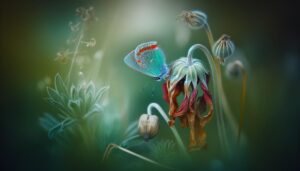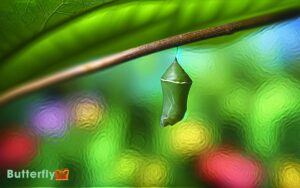Unique Characteristics of the Sea Butterfly
The sea butterfly, or Thecosomata, is a pelagic gastropod notable for its wing-like parapodia used for locomotion and its delicate aragonite shell. These tiny organisms, ranging from a few millimeters to several centimeters, inhabit open oceans and show remarkable adaptability, from polar to tropical waters, across depths exceeding 1,000 meters.
Functioning as both predator and prey, they play an essential role in marine ecosystems and biogeochemical cycles. However, their high sensitivity to ocean acidification, temperature changes, and pollution poses significant conservation challenges.
Unearthing more can reveal fascinating insights into their ecological importance and the environmental risks they face.
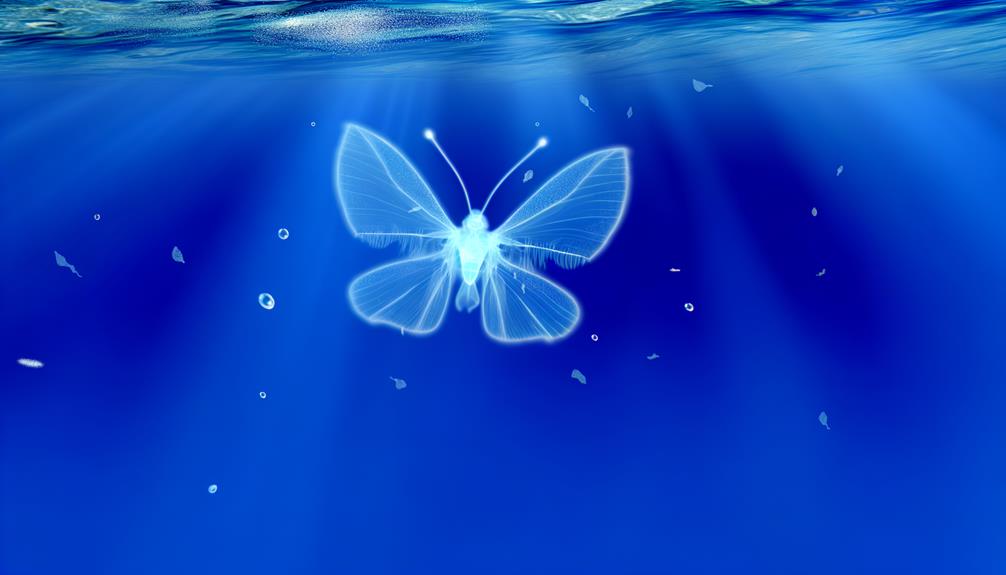
Key Takeaways
- Sea butterflies are small marine gastropods with wing-like parapodia for swimming.
- They possess translucent, aragonite shells that provide minimal protection and buoyancy.
- These creatures inhabit open oceans, thriving in both polar and tropical waters.
- They are crucial in the pelagic food web, serving as prey and predator.
Physical Characteristics
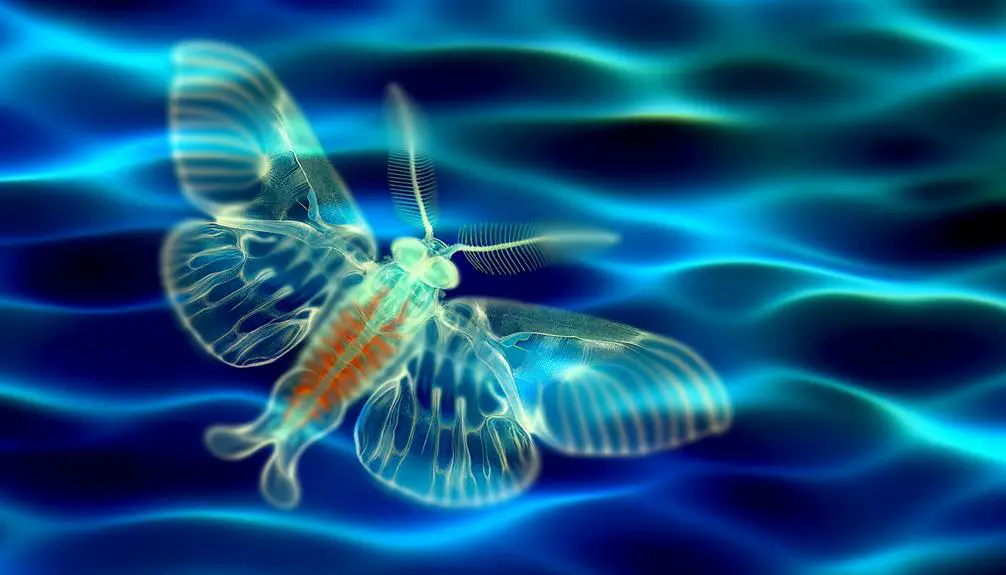
The sea butterfly, known scientifically as Thecosomata, exhibits a distinguishing morphological trait of wing-like parapodia that facilitate its unique mode of locomotion through the water column. These parapodia are lateral extensions of the foot, enabling a flapping motion that propels the organism in a graceful, swimming manner.
Thecosomata possess a delicate, often translucent shell, primarily composed of aragonite, which provides minimal protection and contributes to buoyancy. Sizes vary from a few millimeters to several centimeters, depending on the species.
Additionally, their body structure includes a well-developed head with tentacles, aiding in feeding and sensory functions. The combination of these physical characteristics makes Thecosomata a subject of interest in marine biology, particularly in studies on pelagic gastropod adaptation and evolution.
Habitat and Distribution
Sea butterflies, or Thecosomata, primarily inhabit the open ocean, thriving in both polar and tropical waters.
These pelagic gastropods are distributed from the surface to depths exceeding 1,000 meters, demonstrating significant vertical migration patterns.
Thecosomata can be found in densities ranging from a few individuals per cubic meter in oligotrophic regions to over 1,000 individuals per cubic meter in productive, nutrient-rich waters.
The Arctic and Antarctic regions are noted for their high abundance, particularly during the summer months when phytoplankton blooms occur.
The global distribution of sea butterflies is influenced by factors such as water temperature, salinity, and food availability. These delicate marine snails are typically found in polar and subpolar regions where cooler waters support their survival. Changes in ocean conditions, including acidification, can significantly impact their populations and distribution. Understanding their habitats is as important as knowing how to identify a butterfly in nature, as both require careful observation of distinguishing features.
Their widespread presence underscores their adaptability to diverse marine environments and their importance in oceanic ecosystems.
Role in the Ecosystem
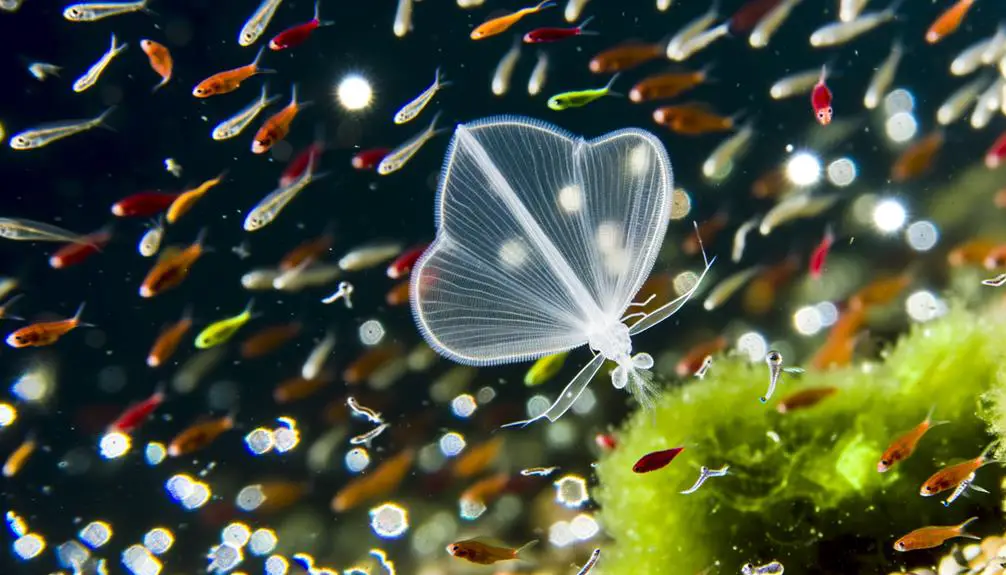
Occupying various oceanic layers, Thecosomata play a vital role in marine ecosystems by serving as both prey and predator within the pelagic food web.
As prey, they are essential sustenance for a diverse array of species, including fish, birds, and larger zooplankton. Their population density can markedly influence the distribution and survival rates of these predators.
As predators, Thecosomata primarily consume phytoplankton and smaller zooplankton, thereby regulating primary production and nutrient cycling within their habitats.
Thecosomata also contribute to the biological carbon pump; their calcium carbonate shells, upon sinking, sequester carbon to the deep ocean, aiding in global carbon regulation.
This dual role underscores their indispensable function in maintaining marine ecological balance and biogeochemical cycles.
Environmental Sensitivity
Subject to various environmental stressors, Thecosomata exhibit high sensitivity to changes in ocean acidity, temperature, and pollution levels. This sensitivity stems from their aragonite shells, which are particularly susceptible to ocean acidification.
Empirical studies highlight the following impacts:
- Ocean Acidification: Lower pH levels result in shell dissolution, impairing their structural integrity.
- Temperature Fluctuations: Elevated temperatures can affect metabolic rates, leading to reduced survival rates.
- Pollution: Exposure to contaminants, such as microplastics and heavy metals, disrupts physiological functions.
- Food Availability: Alterations in plankton populations, their primary food source, impact growth and reproduction.
Understanding these sensitivities is essential for predicting the future viability of Thecosomata populations in a rapidly changing marine environment.
Conservation Challenges
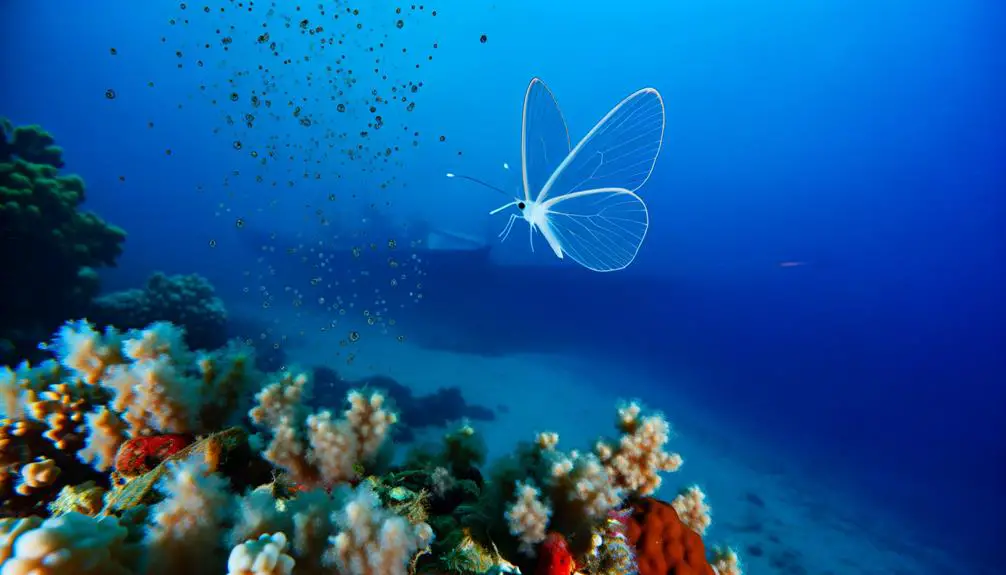
Conservation of Thecosomata faces significant challenges due to their extreme sensitivity to environmental changes and the ongoing degradation of marine ecosystems. Ocean acidification, driven by increased CO₂ levels, drastically reduces calcium carbonate availability, which is critical for their shell formation. Additionally, rising sea temperatures and pollution further threaten their survival.
| Threat | Impact on Thecosomata |
|---|---|
| Ocean Acidification | Impaired shell formation |
| Rising Temperatures | Altered metabolic processes |
| Pollution | Habitat contamination |
| Overfishing | Disruption of food web |
| Climate Change | Habitat loss |
These threats underscore the urgent need for targeted conservation strategies, including reducing CO₂ emissions and mitigating pollution. Without immediate action, Thecosomata populations may face severe declines, disrupting marine biodiversity and ecosystem stability.
Conclusion
Sea butterflies, or pteropods, serve as the canaries in the coal mine for marine ecosystems.
Characterized by their delicate, translucent shells and wing-like parapodia, these small gastropods inhabit the open ocean, contributing considerably to the marine food web and carbon cycle.
However, their sensitivity to ocean acidification and rising temperatures poses grave threats to their populations.
Urgent conservation efforts are imperative to safeguard these organisms and, by extension, the intricate balance of oceanic life.


